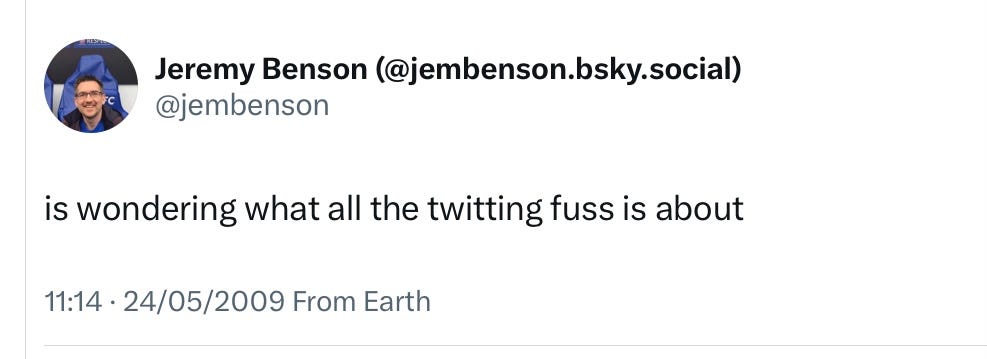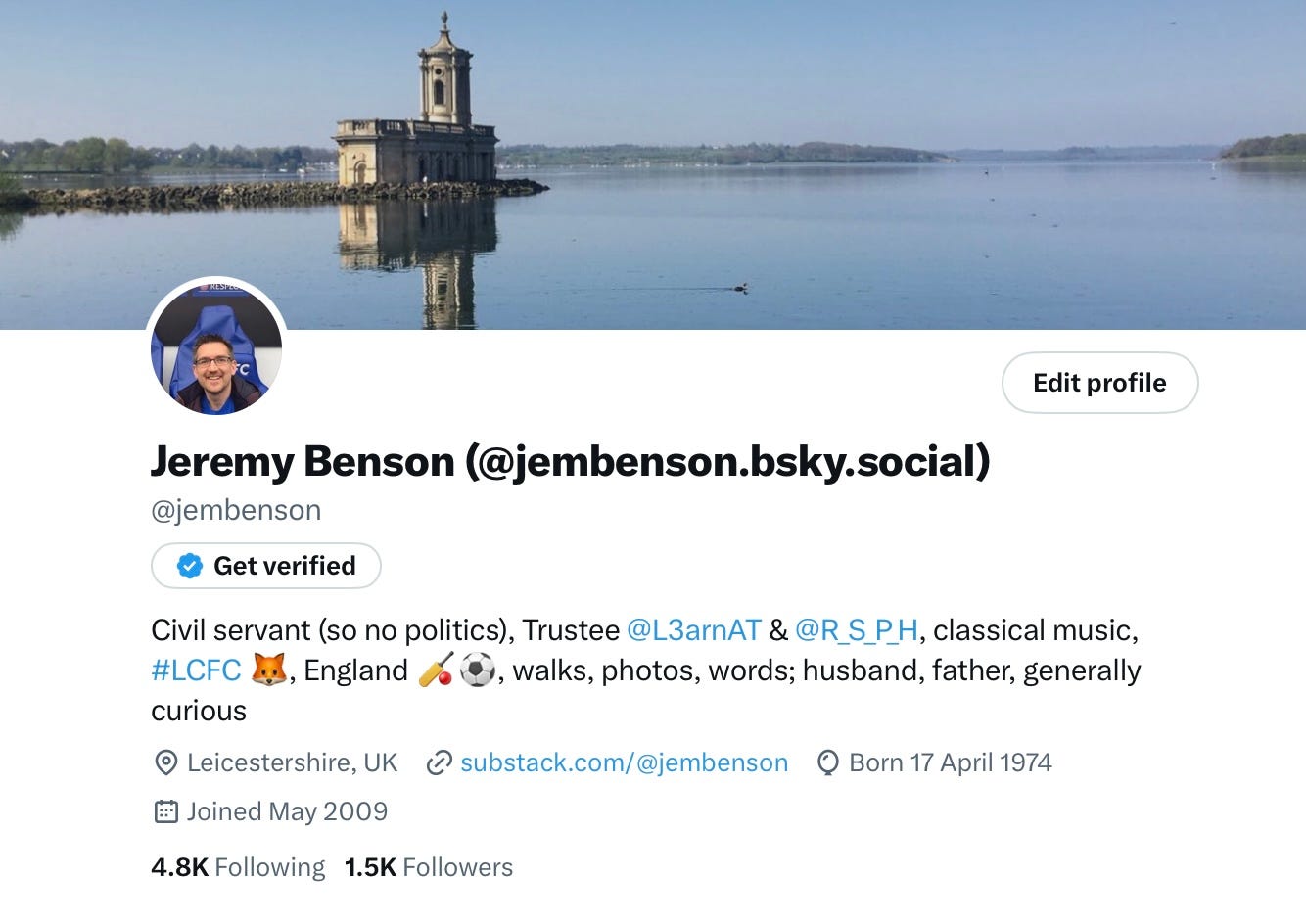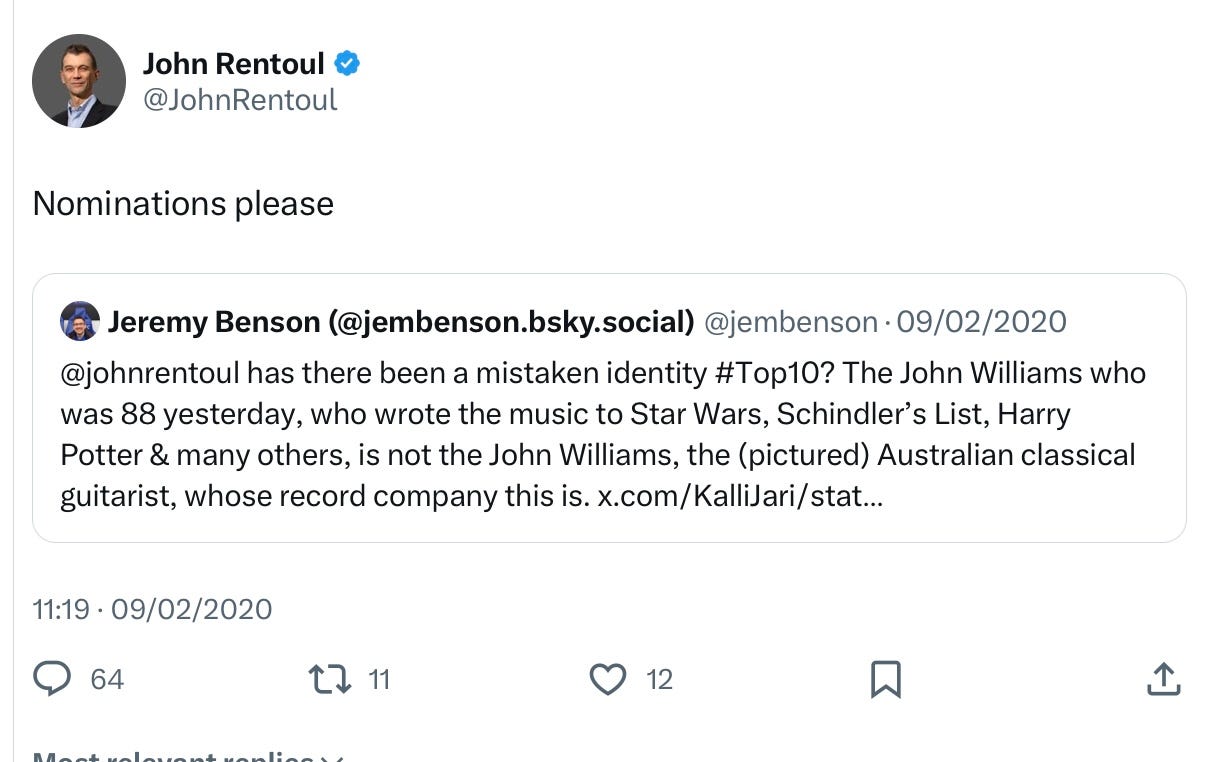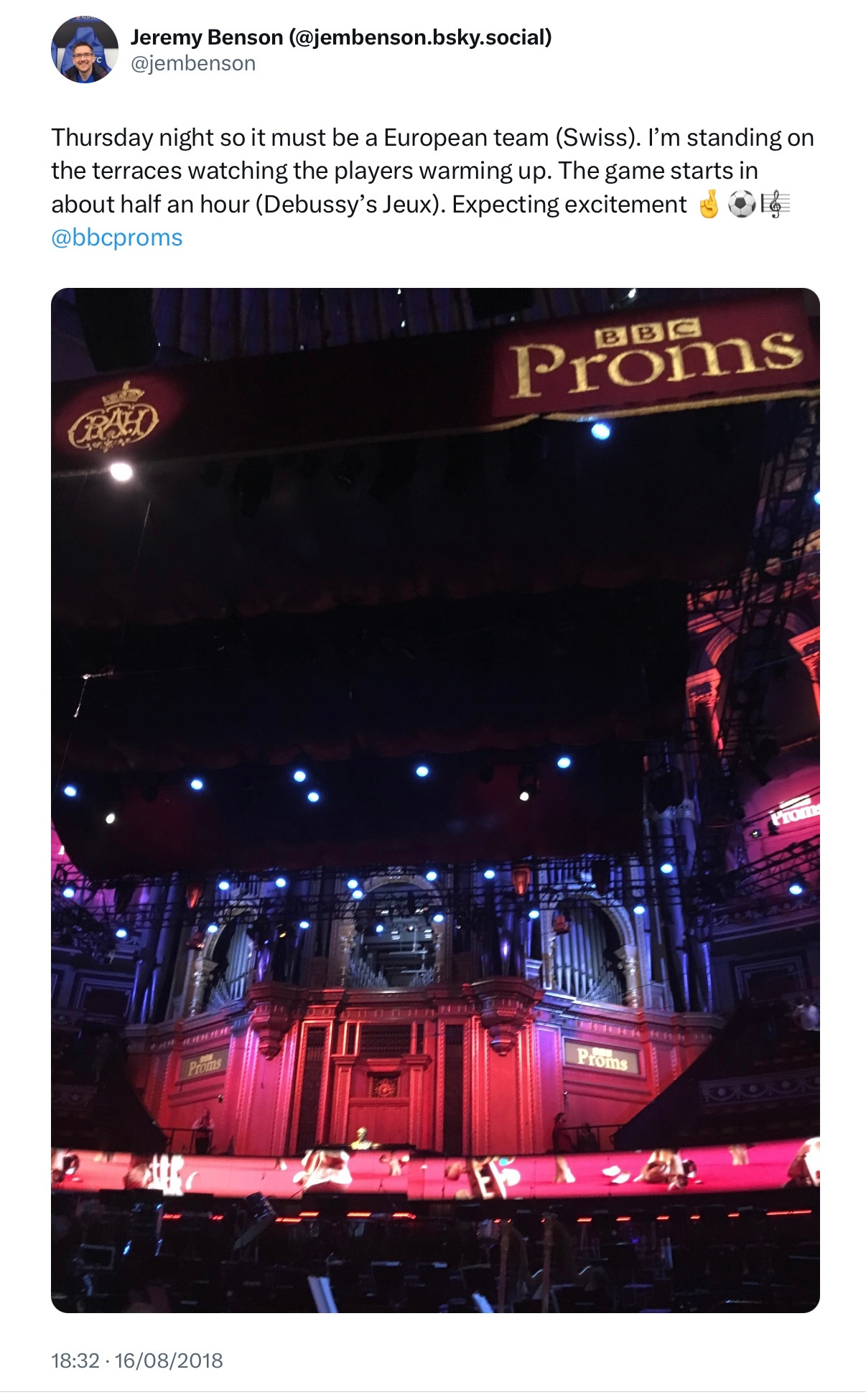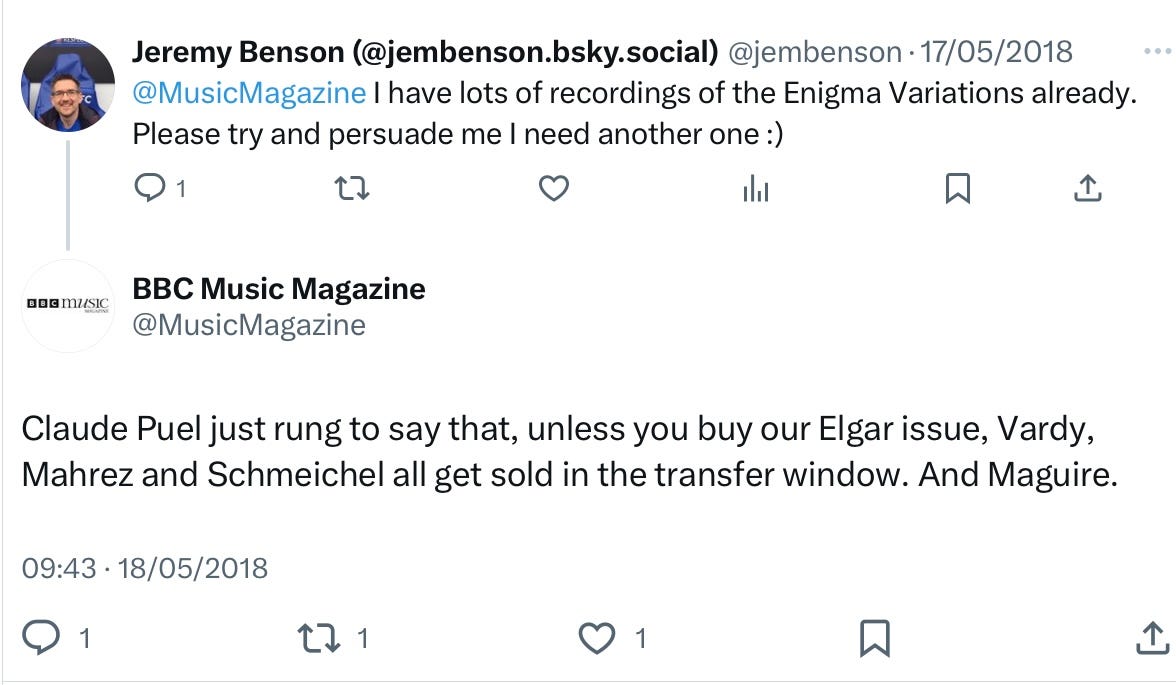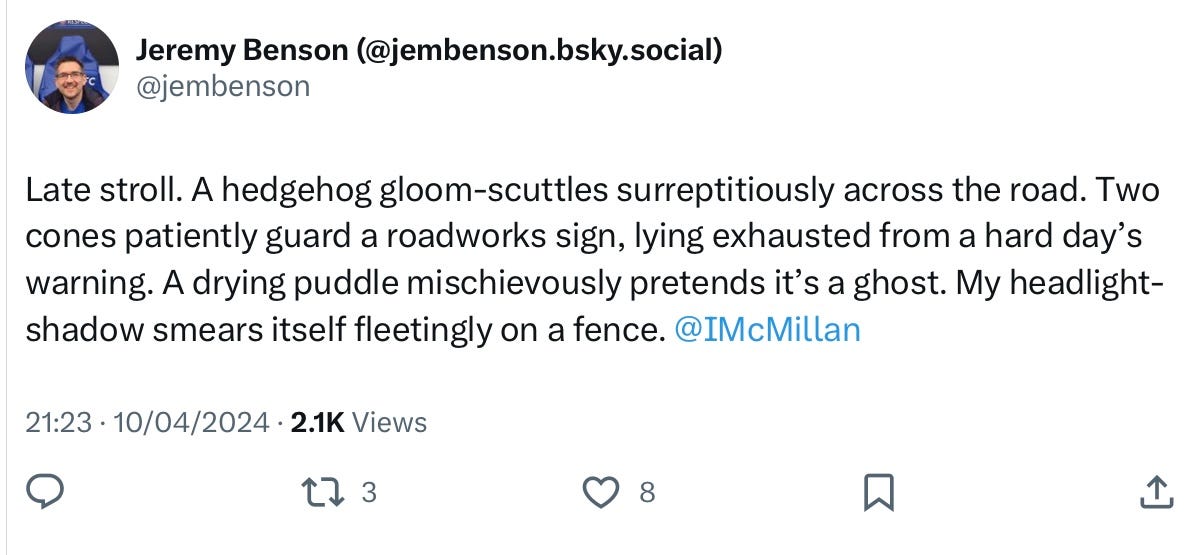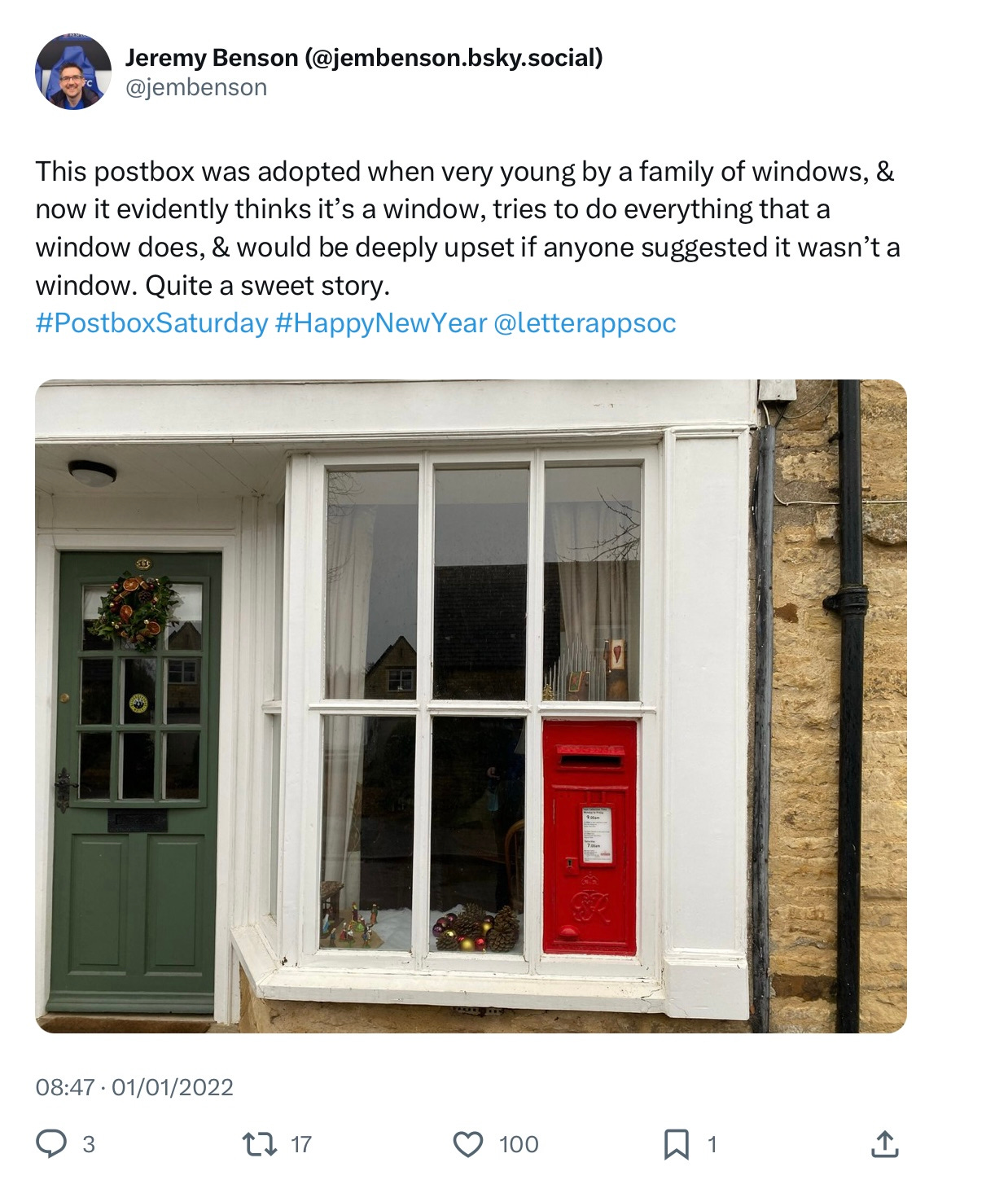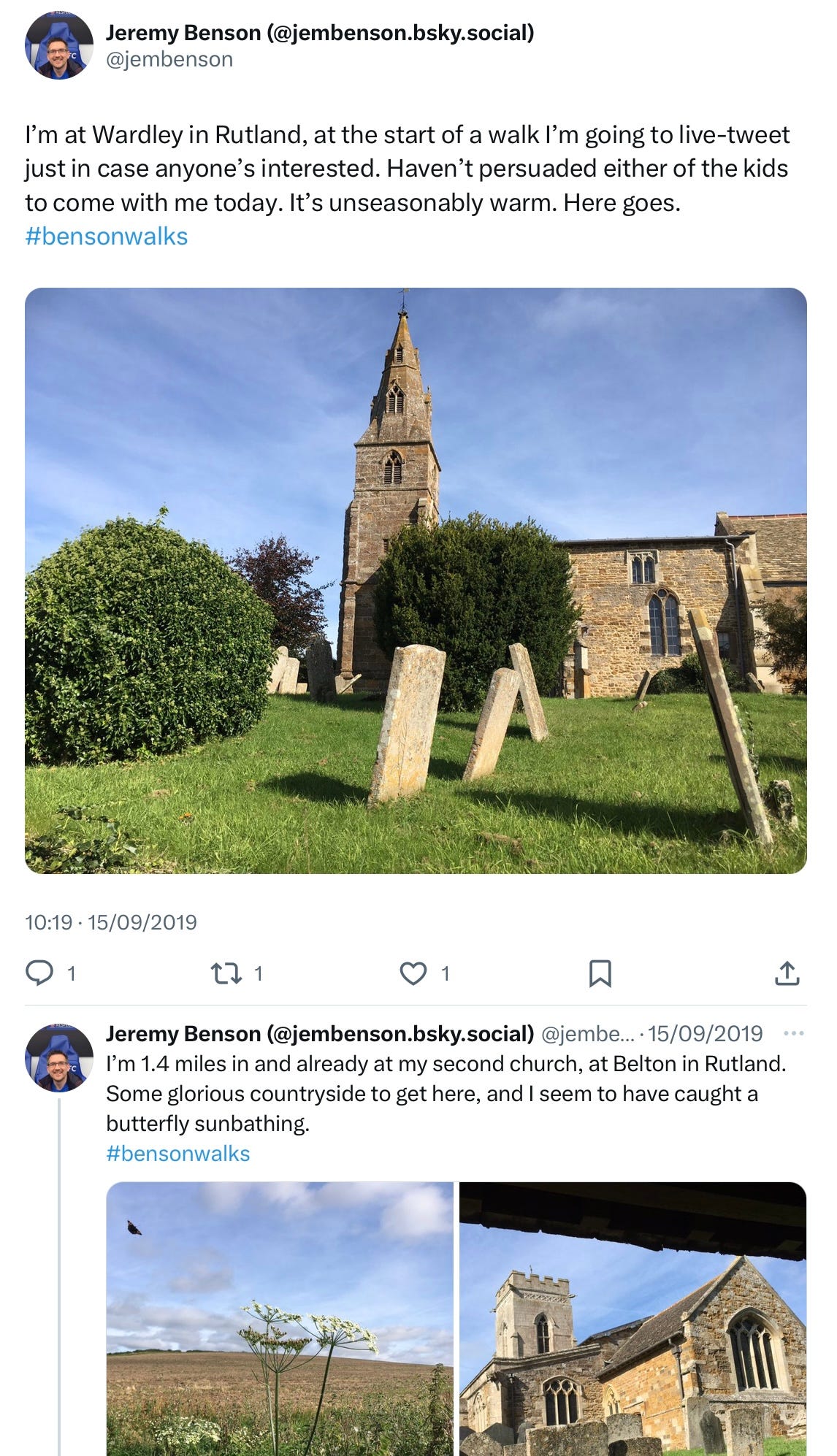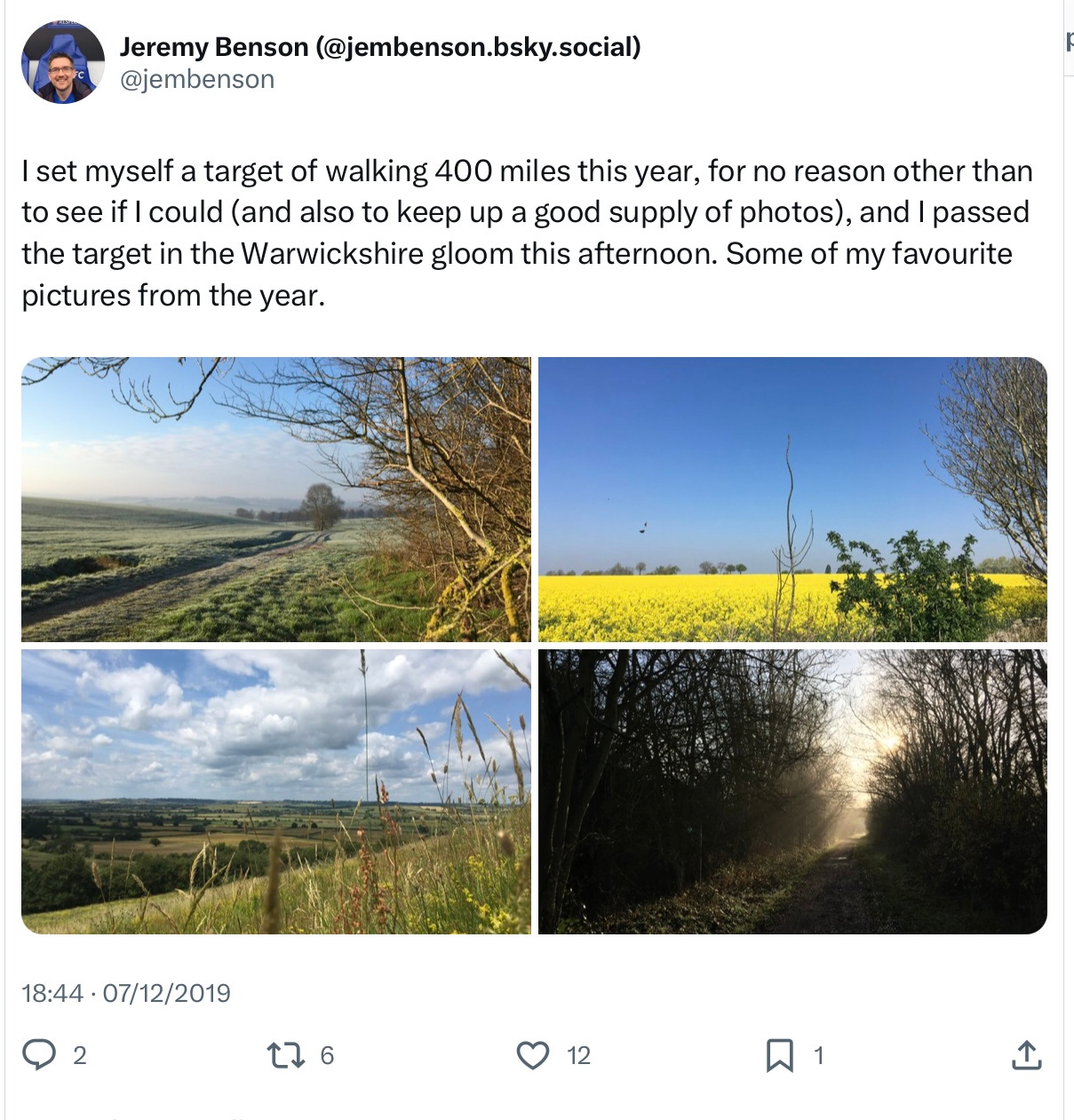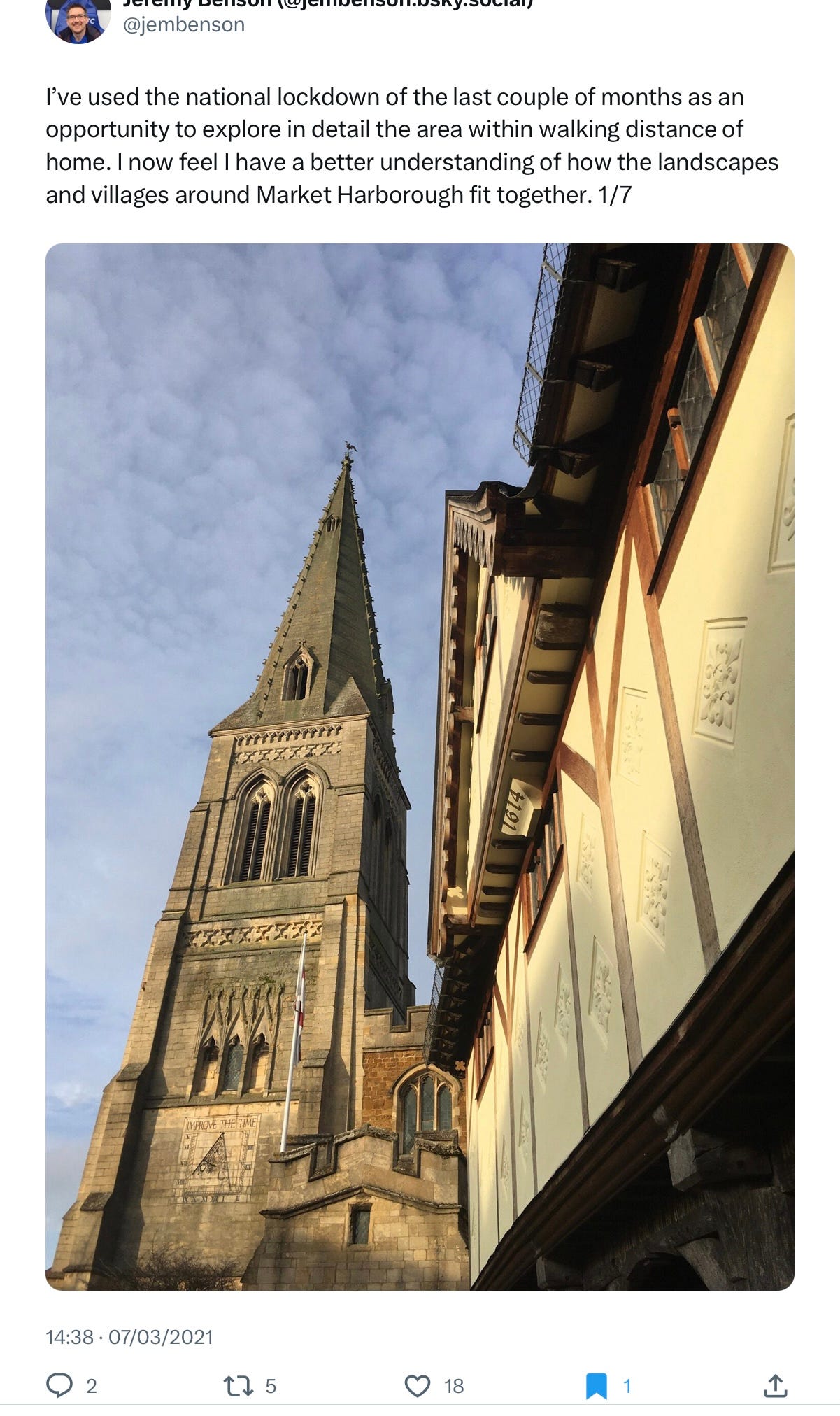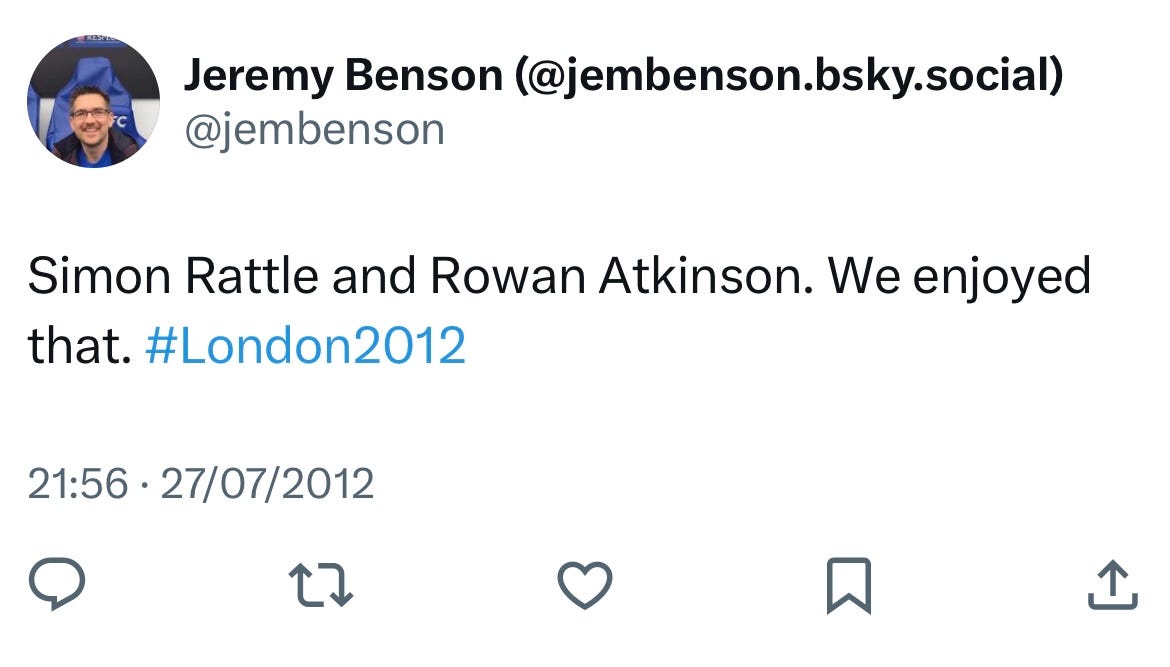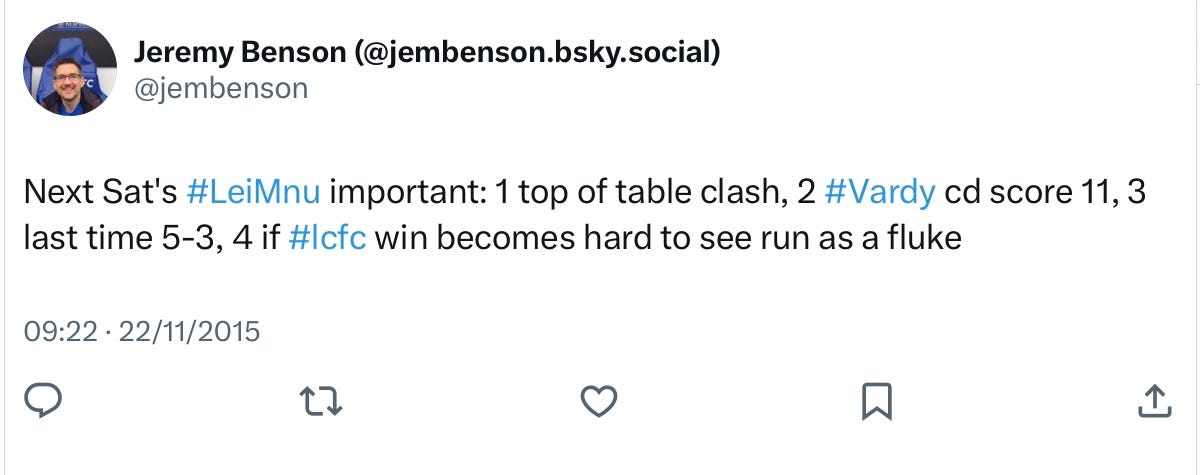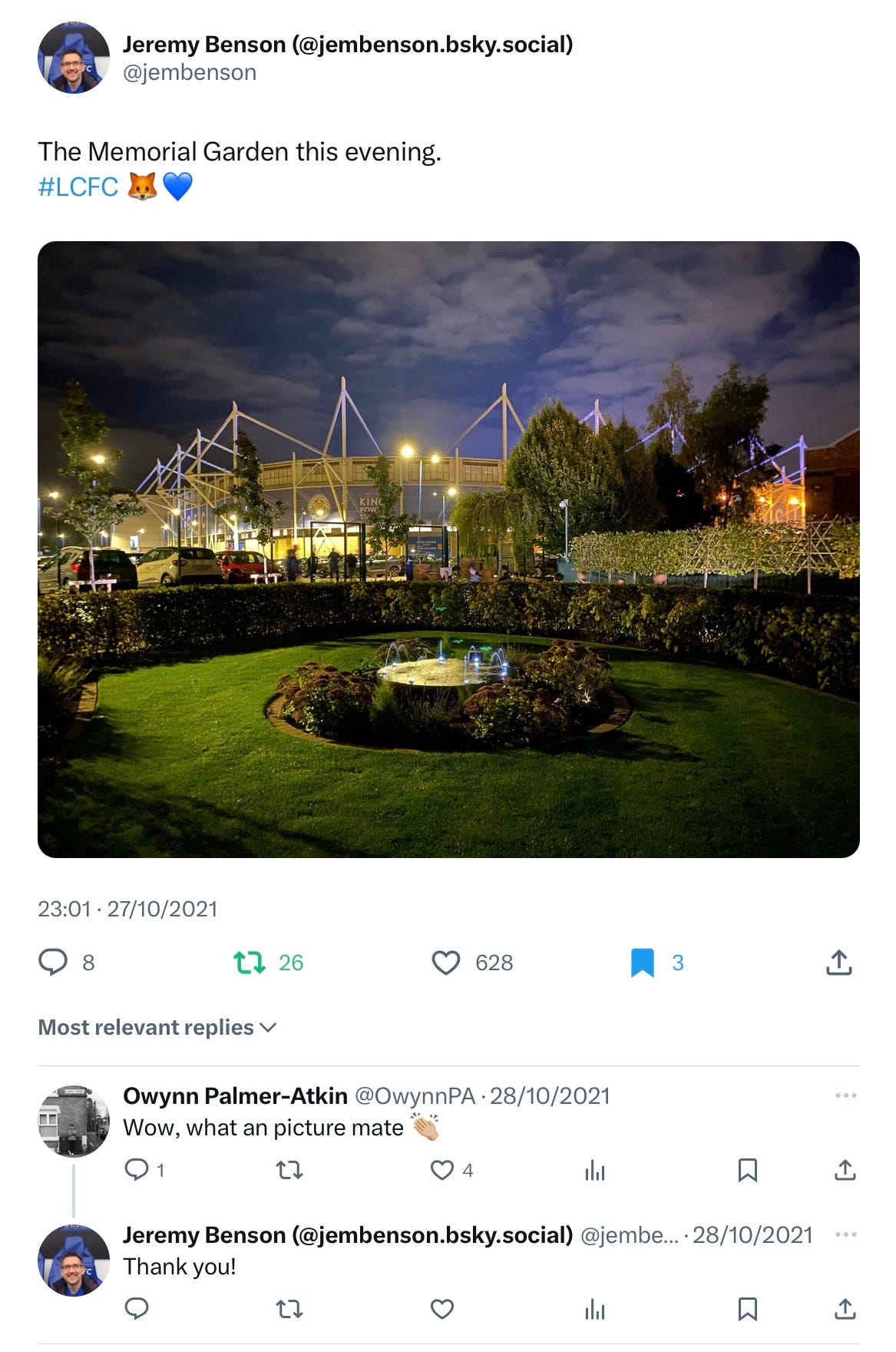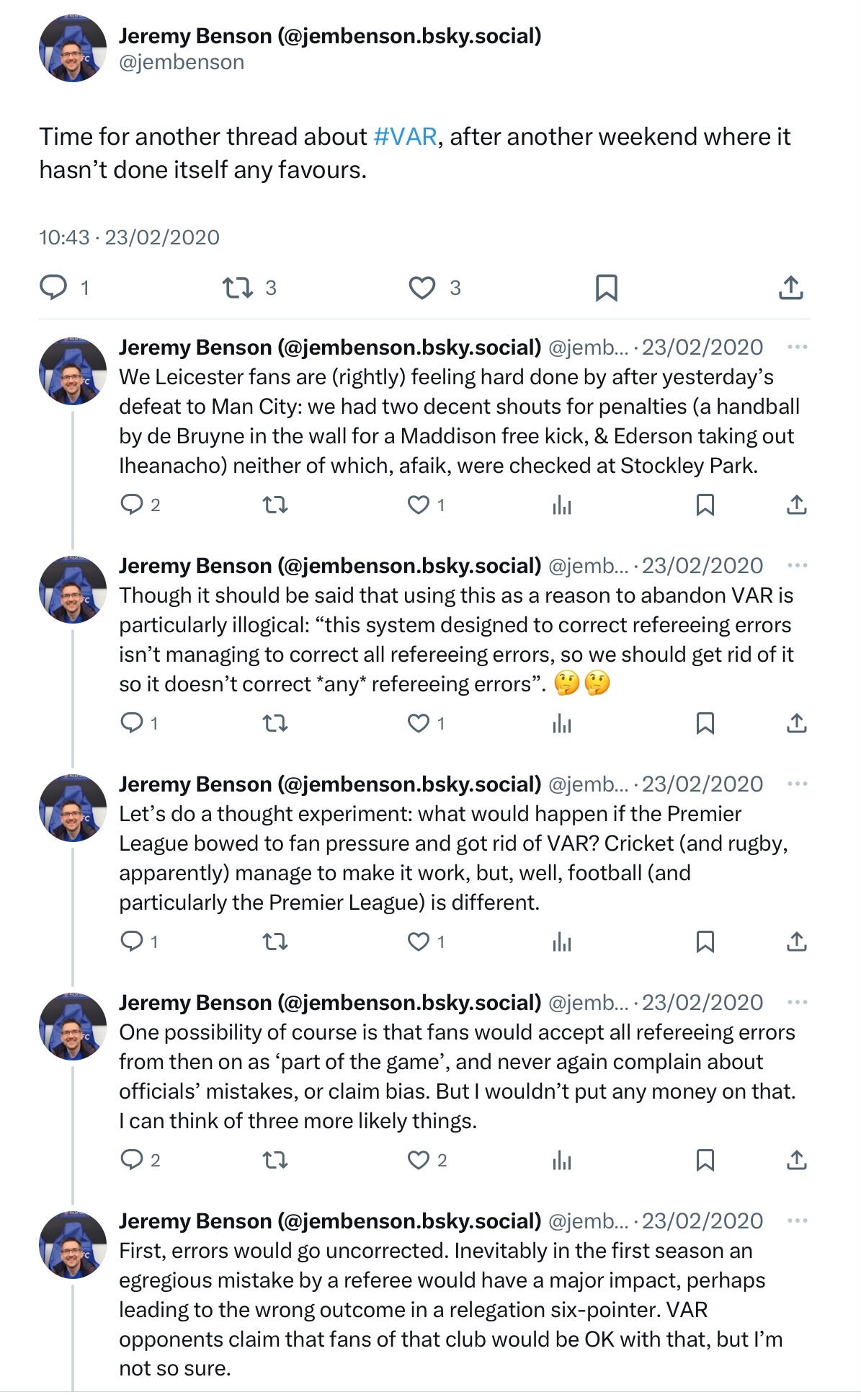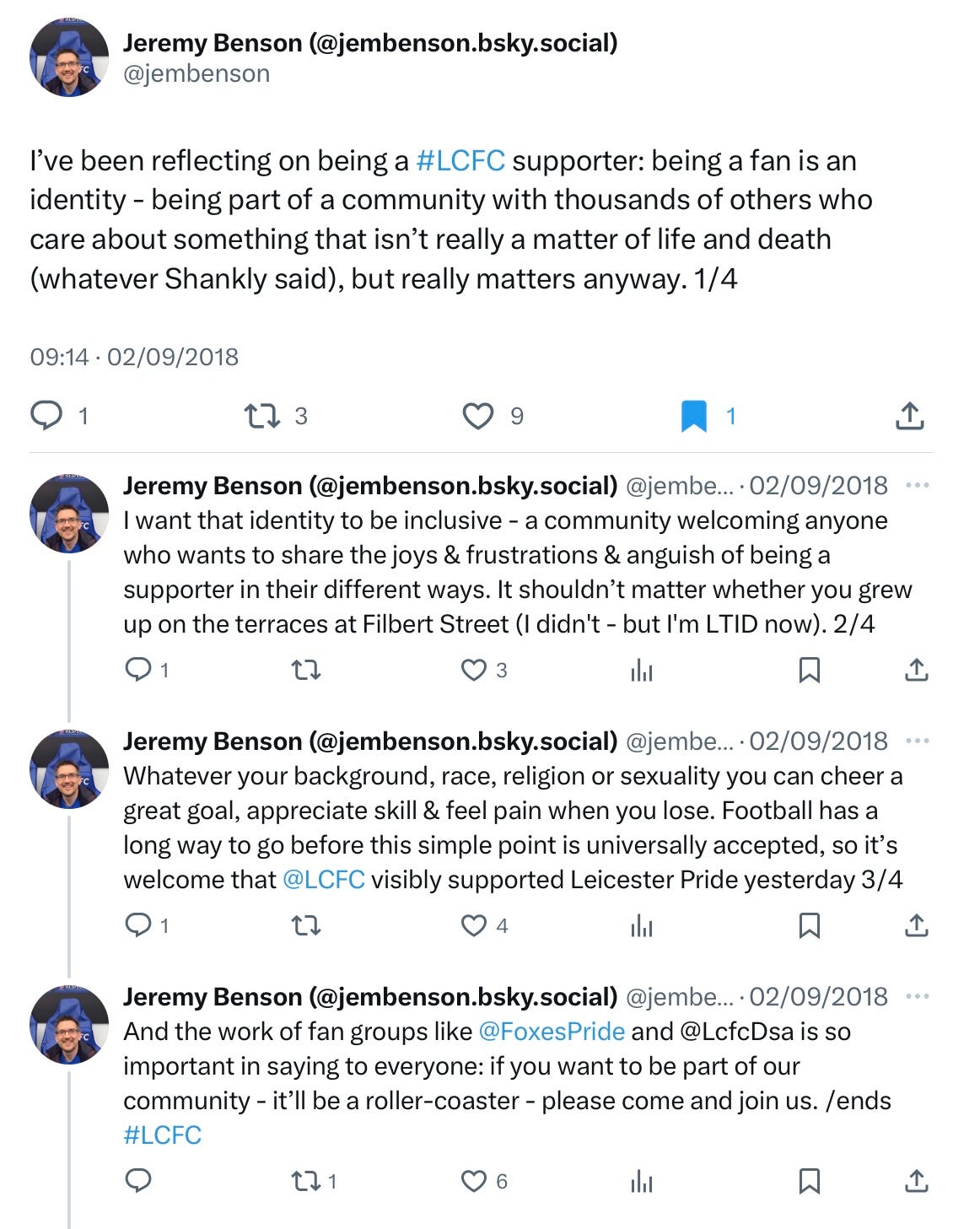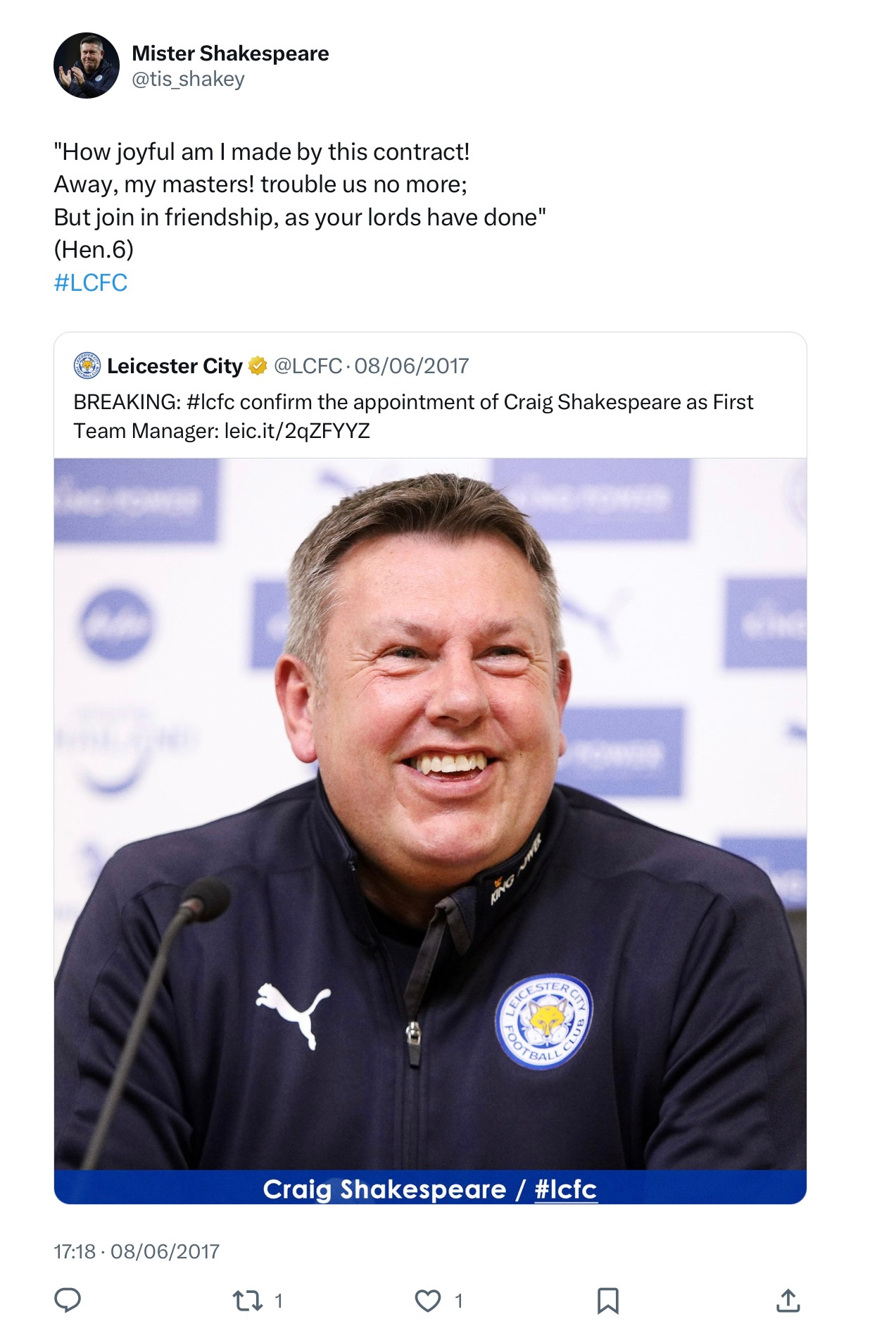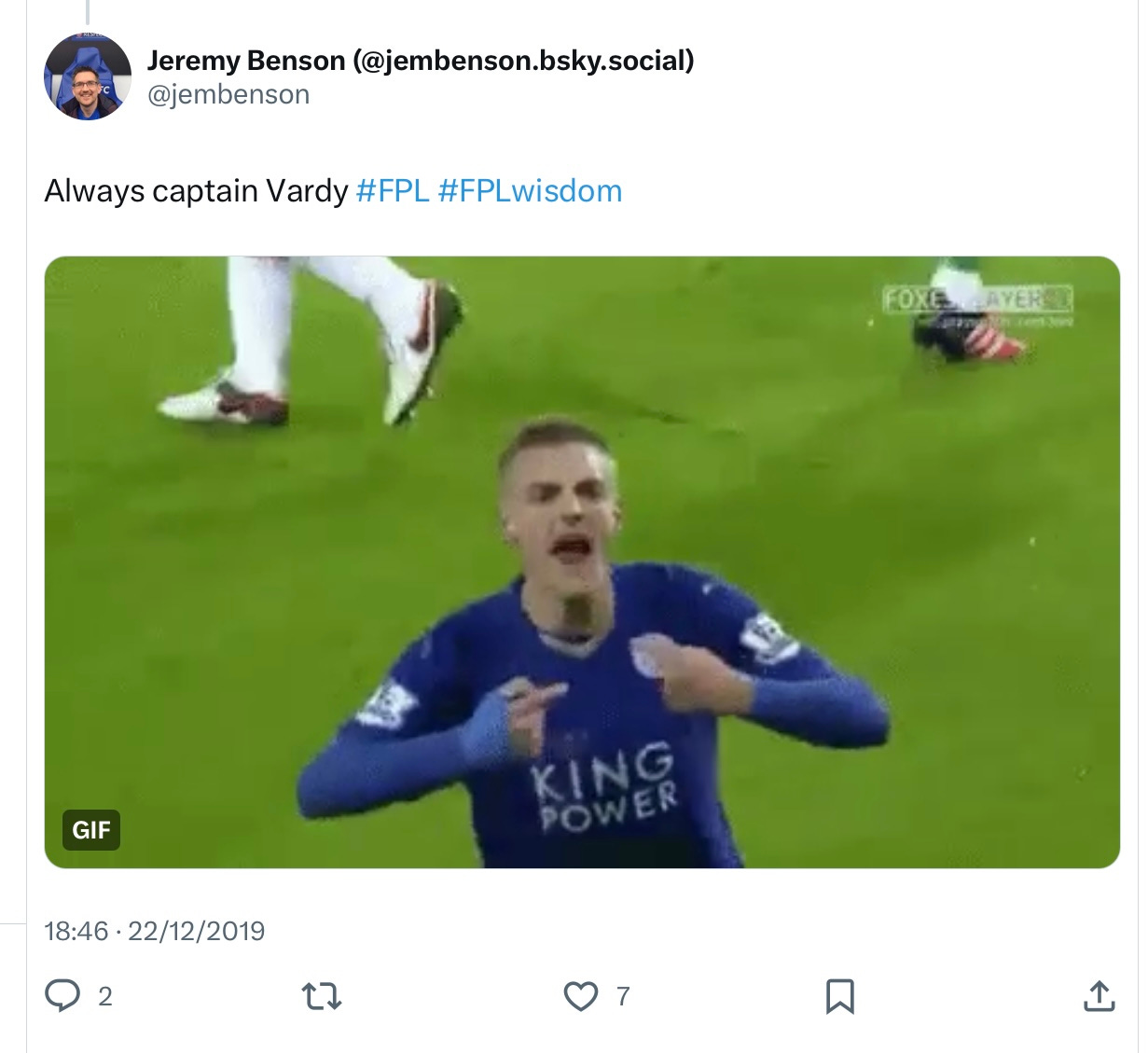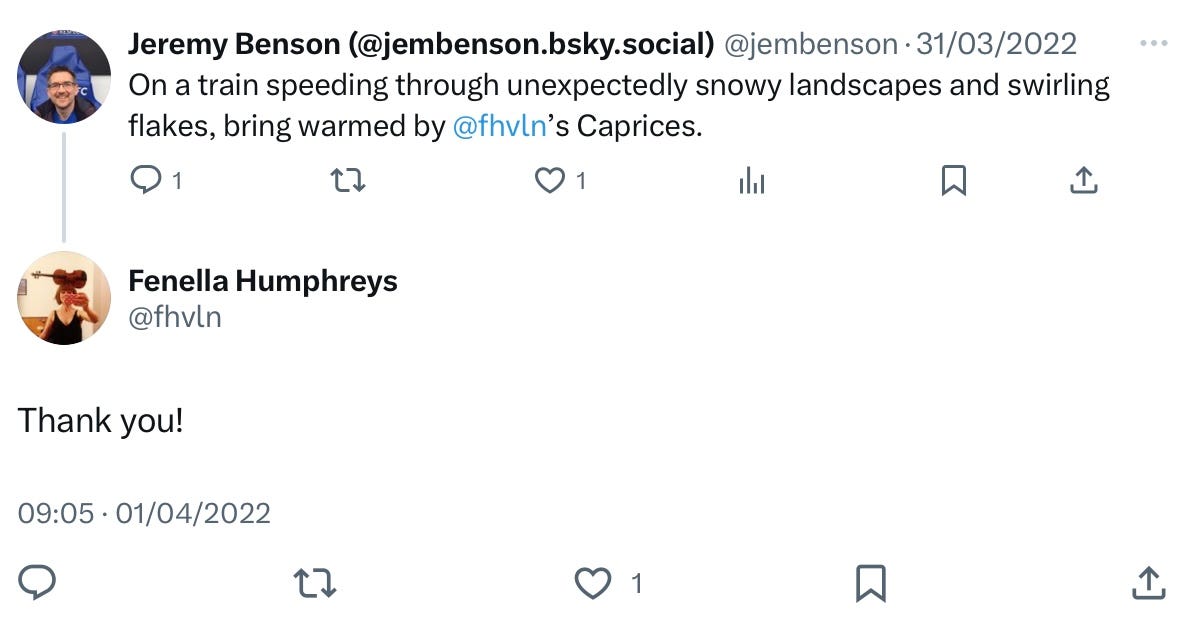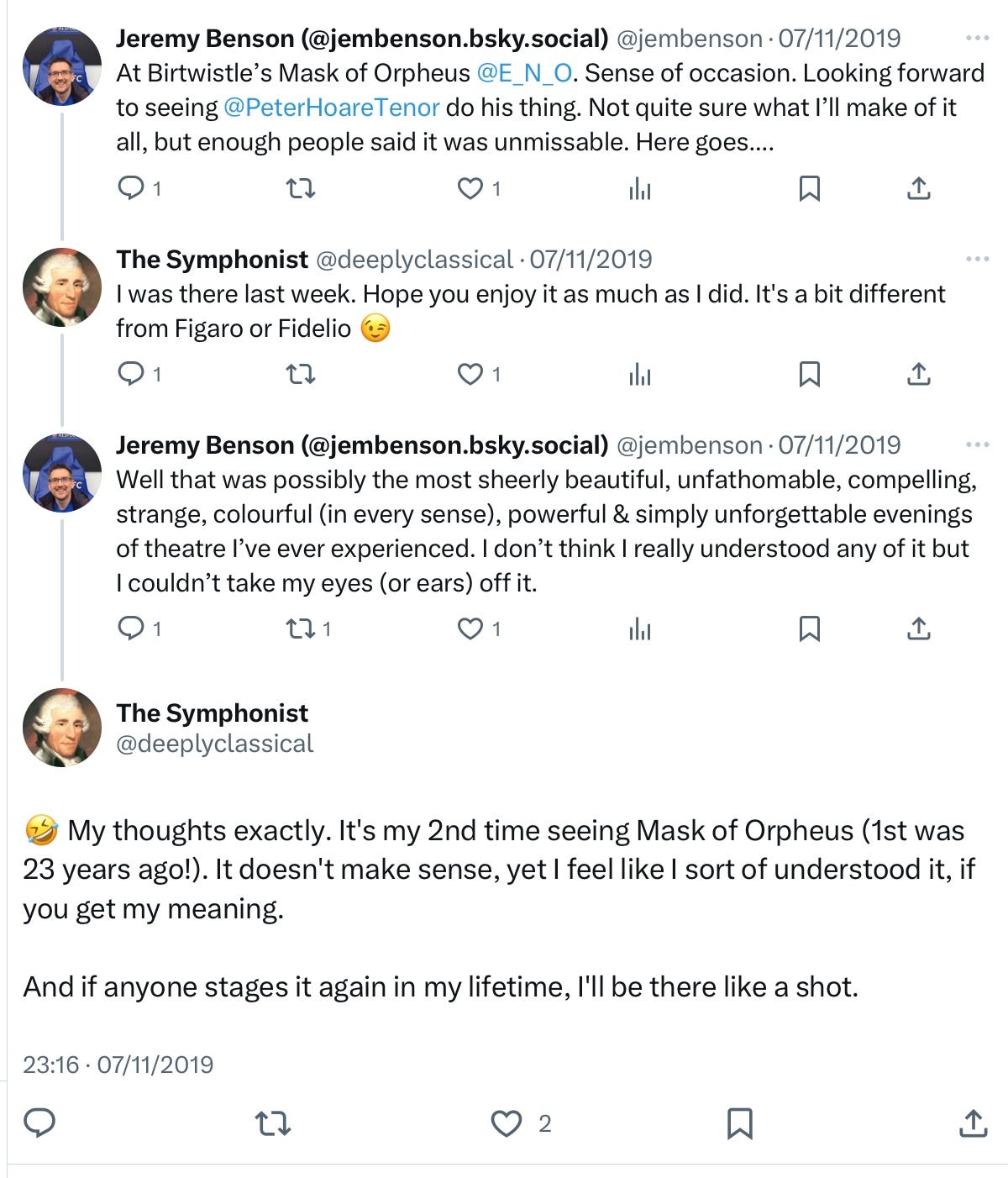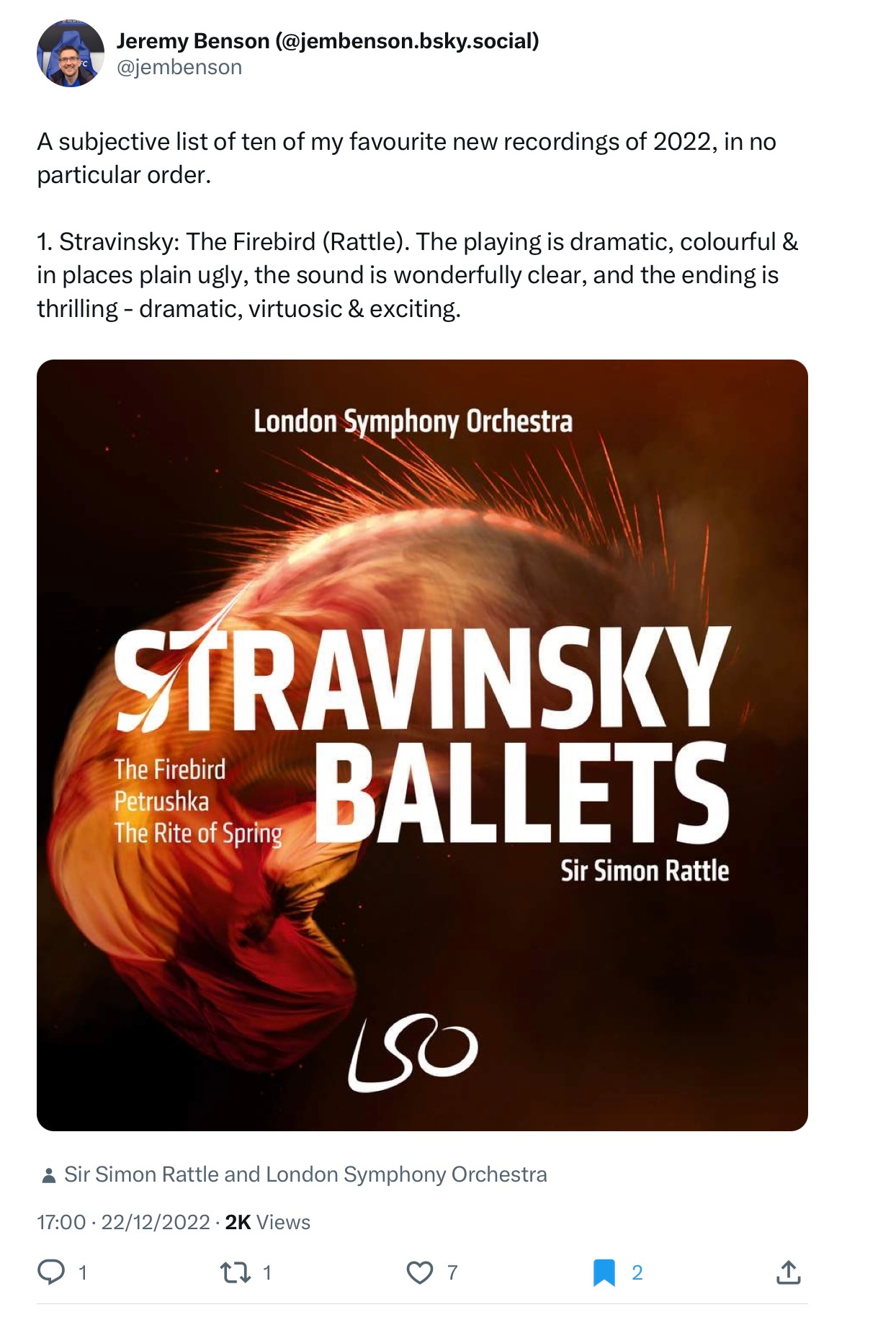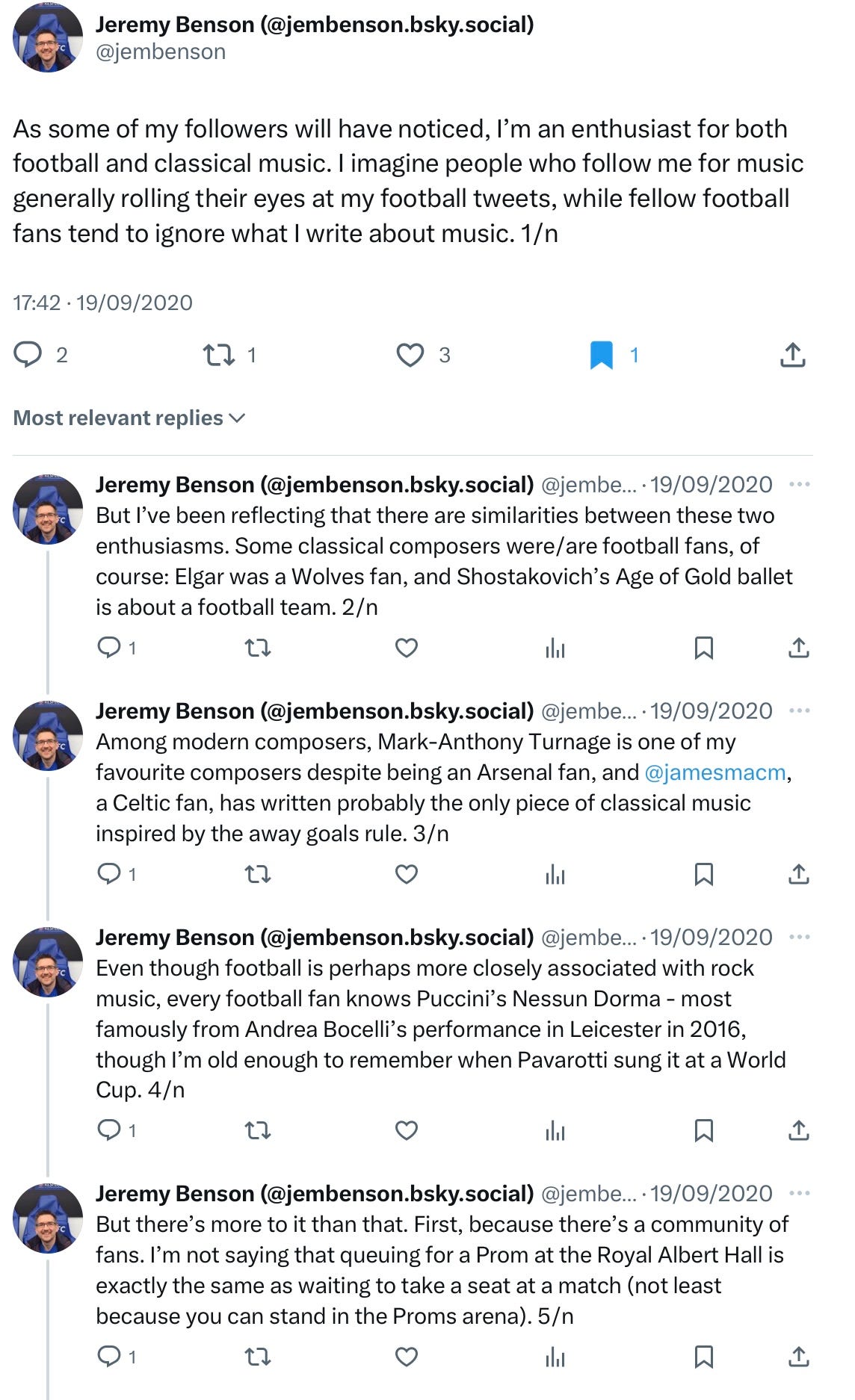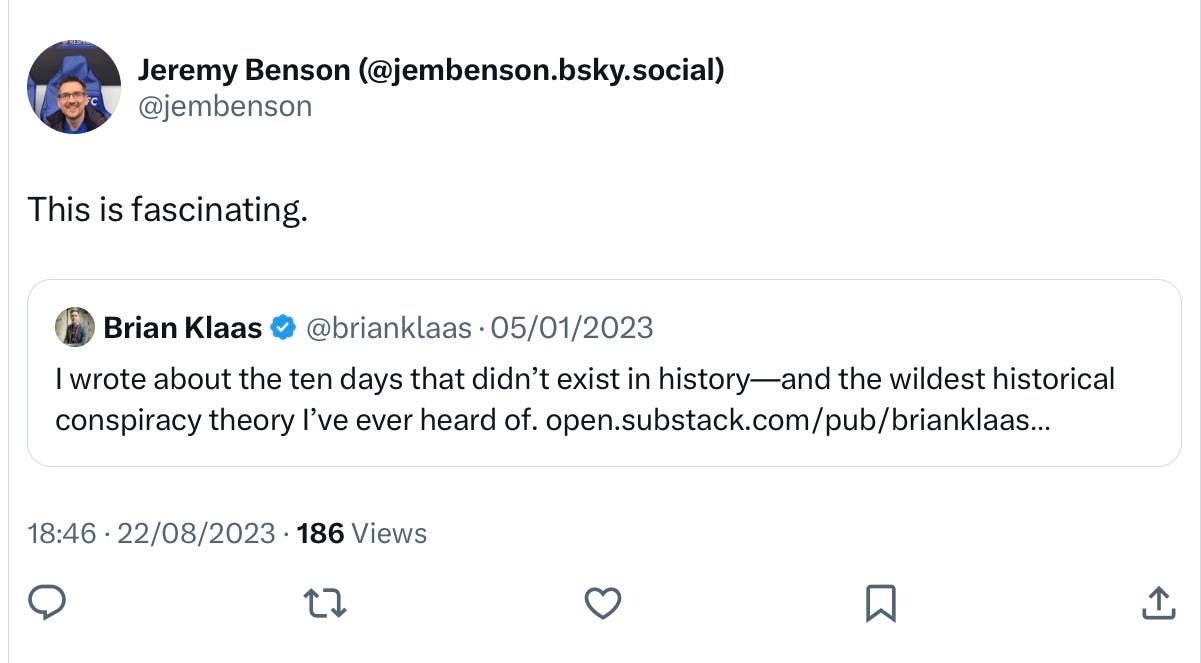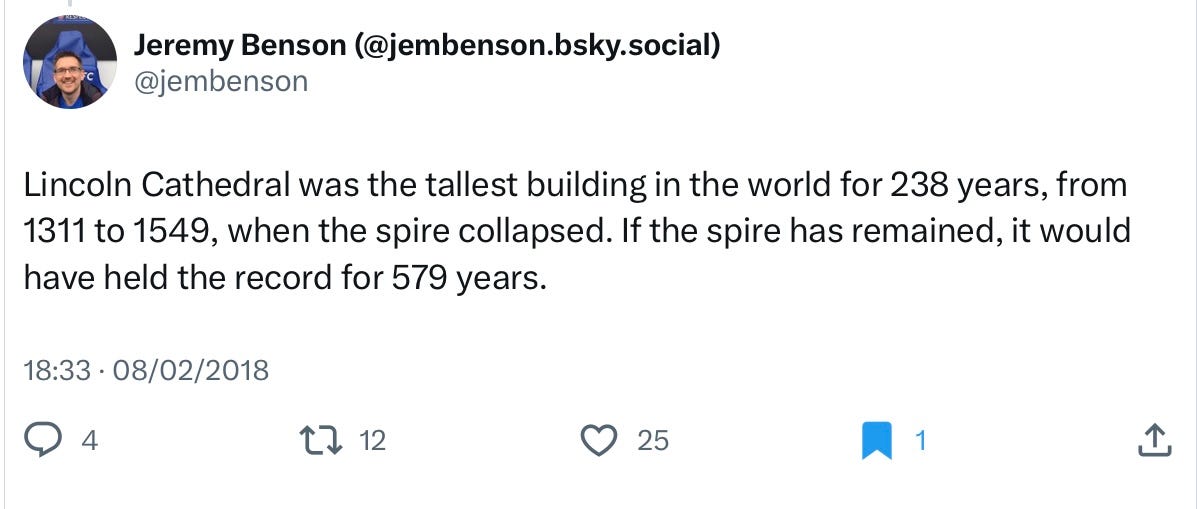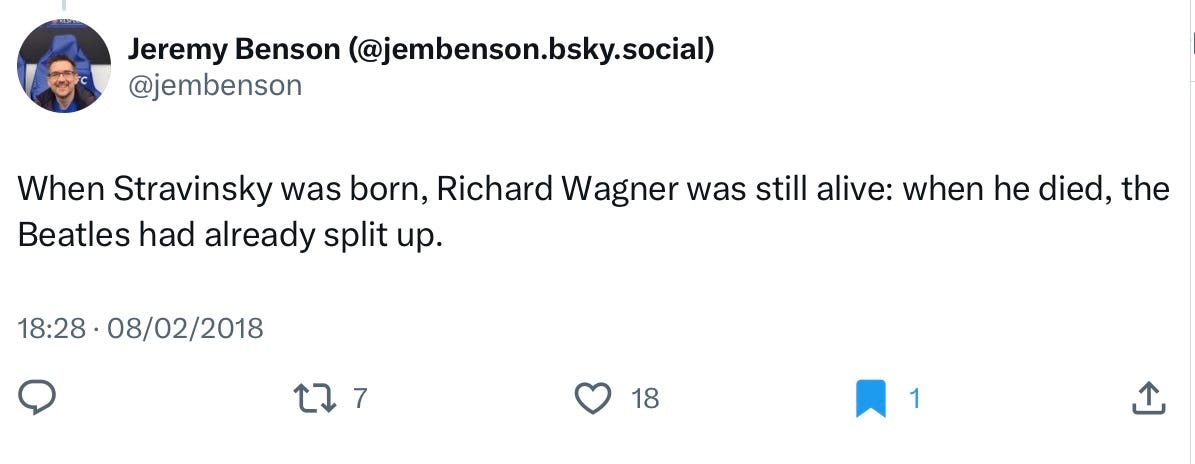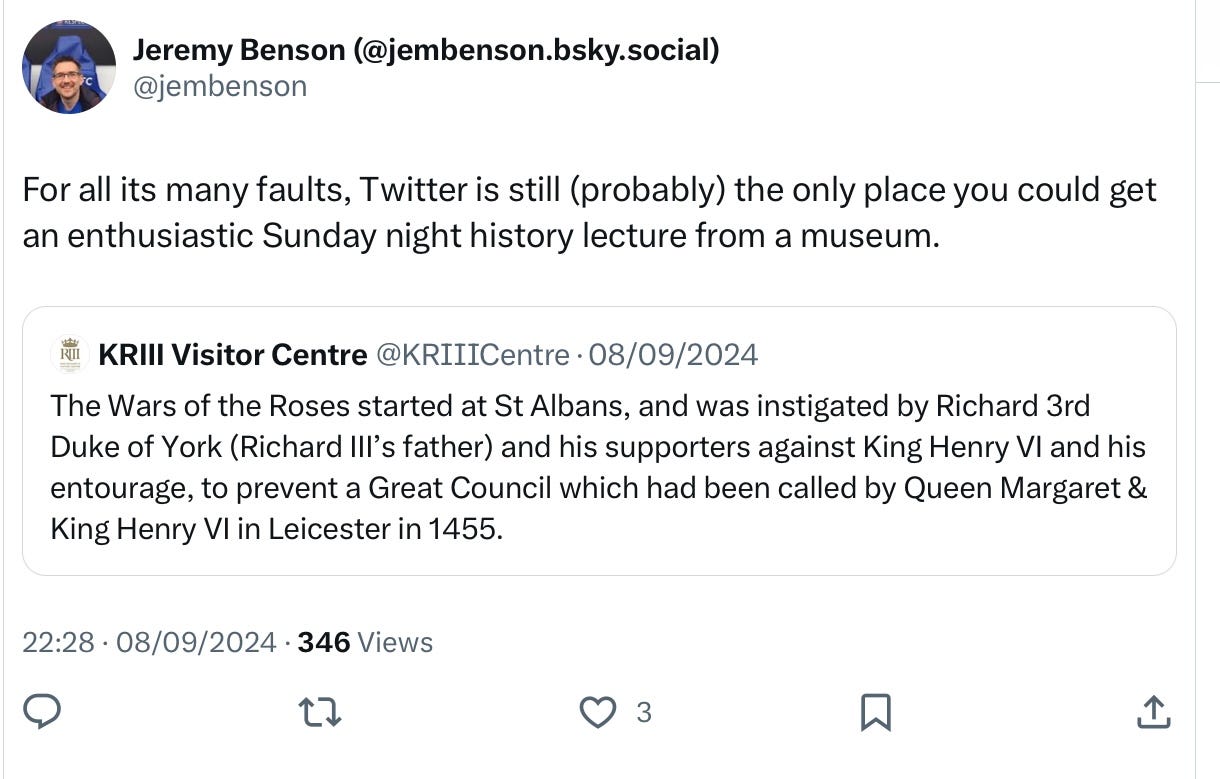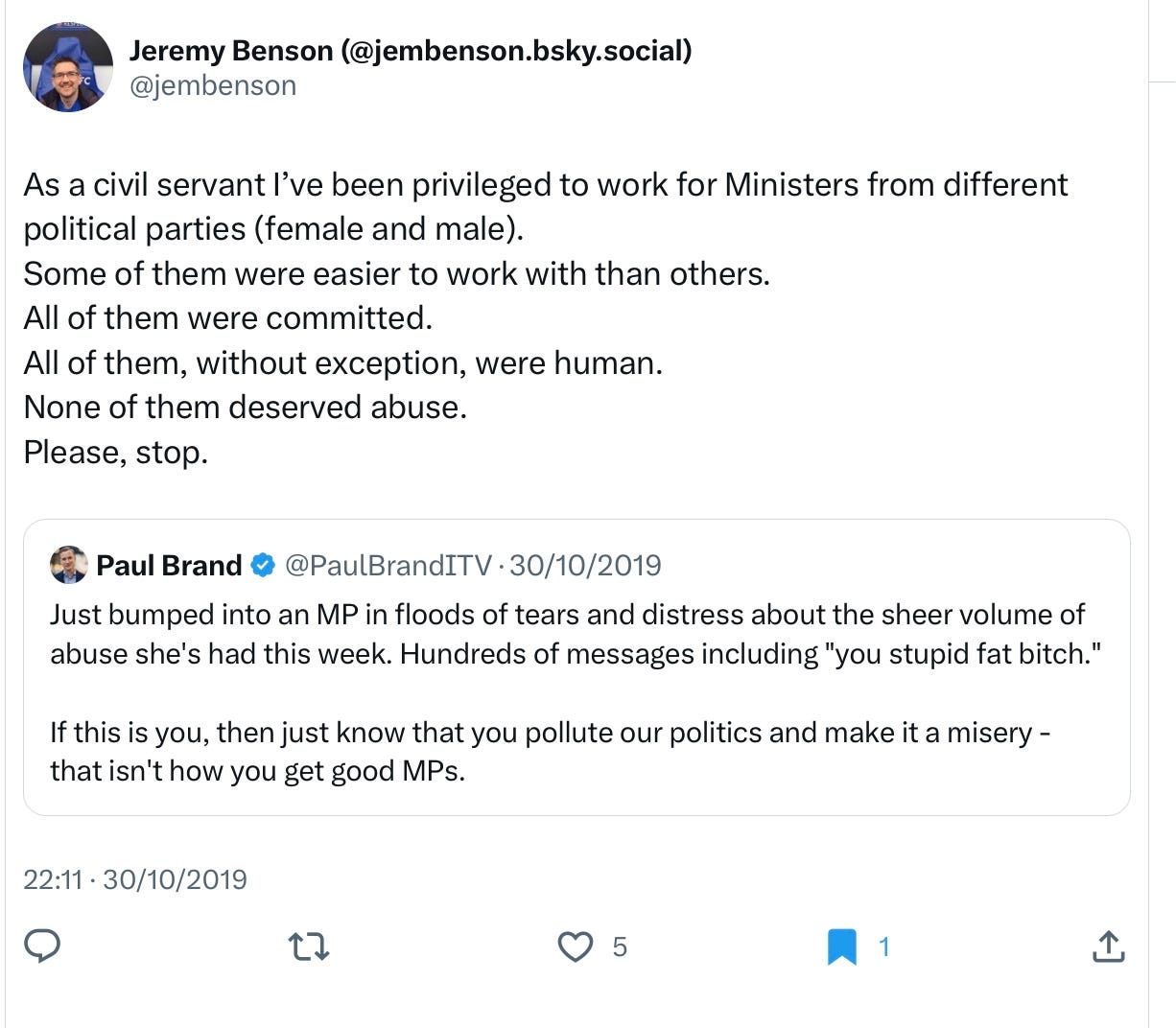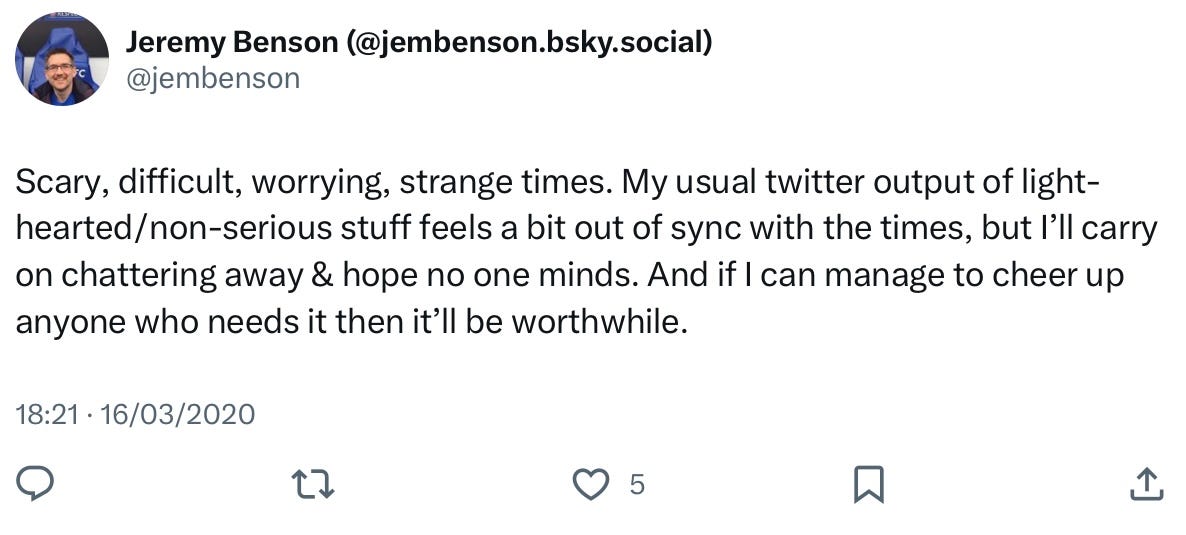On 1 January 2025 I pinned a post on Twitter (now rebranded for some reason as ‘X’1): ‘Happy new year! From now on I’ll mostly be at the other place. Do say hello if you’re there.’ And I removed the Twitter app from the homescreen of my phone, to make it harder for me to find (though I confess I have still managed to sometimes). The process of weaning myself off the app thereby began in earnest, which feels strange because it’s been such a big part of my life over the last few years, for better and for worse. When I post a link on Twitter to this piece, I expect that may be my last ever Tweet.
Recently many people have been leaving Twitter (sometimes quite loudly) for political reasons, but I’ve never got involved in the politics of it. Mostly I’m going because Twitter is a lousy experience now - there are lots of annoying, unblockable ads, and many of the people I used to follow who made Twitter fun have departed or gone silent, replaced by a stream of bots.
So Twitter now is like a half-abandoned building you remember when it was in its prime: you walk along empty corridors, recalling the good times, hearing echoes and the occasional laugh. There are still alarming noises from some of the rooms you always avoided. Some people are still there, doing their best, but the energy and serendipity has mostly gone, probably irretrievably.
An alternative, called Bluesky (the ‘other place’ I was referring to in my pinned post) has recaptured some of that old spirit, with many of the people from Twitter now there instead, and I’ve got to the point where I want to close the Twitter chapter and move on, rather than try and ride both social media horses. I also now use Substack to publish thoughts I might once have started on Twitter2. But I can never forget that I started a lot of things on Twitter, even if their future will be elsewhere.
So this seems like a good time to reflect on my Twitterlife and what it’s meant to me. This is not to say there was anything special about my Twitter experience - there were many people who did it far better than me (and people who spent a lot more time on it than I did…) But that’s part of the point: the real value was not in the app itself, but in the networks and connections it enabled, allowing people to learn from and be inspired by others, which I certainly was.
Social media has gained a bad reputation over the last few years, for understandable reasons: it has enabled terrible abuse of some individuals (particularly women and people from ethnic minority backgrounds), coarsened debate and legitimised extremism. Indeed, an increasing amount of social media energy is now spent complaining about social media.
But I’ve managed to avoid most of that anger and unpleasantness, mostly because - as a civil servant (and I have never hidden my identity) - I am not allowed to express political views or engage in controversial debates (other than the occasional bad football opinion). So I’ve largely managed to avoid the bad bits and enjoy the rest.
Of course it’s not been entirely good. Occasionally I’ve found myself mindlessly scrolling through my Twitter timeline, vainly hoping I might find something interesting to read, or checking and rechecking the app in the hope of the dopamine hit of a notification indicating something small has happened, such as someone “liking” one of my Tweets.
But the good bits more than make up for that: I have become part of communities of interests I may never have found IRL3, and made sort-of friends with people I’ve mostly never met and may never do (which certainly made Covid lockdowns a bit easier). I have been able to engage with and listen to some amazing people. I have become more creative and more outward looking. It has given me new perspectives and opportunities. I have learnt lots of things. I have shared the communal experience of watching sporting and other events. There has been whimsy and daftness and laughter. I have even got onto local radio. And though it has been serious at times, above all it has been good fun.
I first joined Twitter in May 2009, when it was only about three years old. I didn’t really see the point of it: ‘is that it?’, I remember thinking. Users could publish ‘Tweets’, little thoughts of up to 140 characters (it’s now double that) which anyone anywhere in the world could read - though generally the only people who will read someone’s Tweets are those who have chosen to ‘follow’ them, as their Tweets will show up in their ‘timelines’. If someone particularly likes a Tweet they can retweet it to share it with their followers too. Series of Tweets are known as ‘threads’. It’s all a bit more complicated than that, of course, but that was - and mostly still is - the essence of it.
But I thought I would give it a go, planning initially to use it to discuss music, as well as - more importantly, at least at first - reading what others thought about lots of things, including for work. At its best, Twitter could be brilliant for picking up what’s going on in the world and seeing how people (including - but emphatically not only - those who know what they’re talking about) were reacting.
I chose a user name, @jembenson - my full name was already taken; my friends called me Jem at school4. And I sent my first Tweet:
That’s what that Tweet looks like in 2025, though it would have looked different at the time5.
That was the first of over 29,000 Tweets I’ve posted in the nearly 16 years since, an average of over five a day. But it took me a while to get going - I sent very few Tweets in the first few years (mostly cricket-related, I think). I was therefore not really worth following: it took me years to get many followers, but I’ve ended up with over 1,5006. That’s 1,500 people (or, strictly, 1,500 people, organisations, bots and who knows what else) who have decided at some point in the last 16 years that I’m worth following. Of course there are plenty of people with tens or hundreds of times as many followers as I have, but for someone with no public profile and limited in what I could say, 1,500 wasn’t a bad total to get to.
This includes a few reasonably famous followers: I still remember my delighted surprise when Karita Mattila (the Karita Mattila) commented out of the blue on some photos I’d posted, and then followed me. Quite a few other well-known musicians and musical writers also followed me, and some football writers, journalists, professors and commentators too. Being able to engage on social media humanises people who would otherwise just be names. Many of these people are now, thankfully, on Bluesky as well.
And here, for the record, is my Twitter bio (what people see when they search for me, if they want to find out something about me), as it’s ended up. That’s a picture of the half-submerged Normanton church in Rutland, and a photo of me sitting in the manager’s seat at the King Power stadium during a stadium tour:
And here are ten things I’ll remember from my time as an active Twitterer7.
Whimsy: for me, this was Twitter at its best: Tweets with one-off observations or thoughts which tried to make people smile or nod or think, and perhaps inspire witty responses. Plenty of people did this far better and to far bigger audiences than I did, such as Ian McMillan, Lev Parikian and Miranda Keeling, but it was always fun to have a go. By definition these Tweets are mostly ephemeral and of the moment, and so don’t bear much repeating, but it was fun to dig out a few of them again and remind myself of the good times. Like the time when (for reasons too obscure to explain) I found myself making up bird names, one for every ‘like’ (these are just the first few):
Once when on a country walk I saw a gate with no fence either side of it and invented the hashtag8 #ExistentialGates, which I have posted about every now and again since, when I’ve seen something similar:
I contributed regularly to the running joke, started by Ian McMillan, that Paul Simon wrote the song Homeward Bound on any number of station platforms (it was actually either Widnes or Warrington, as respondents not in on the joke would always point out in response). It made an entertaining diversion to post a picture and a reference to the song whenever I found myself waiting at an unfamiliar railway station - for example:
The political commentator John Rentoul used to do weekly ‘Top 10’ lists of random things in the Independent on Sunday, seeking suggestions via Twitter. I contributed to a few of them9, and once or twice I inspired lists:
I riffed on my love of both football and classical music when I pretended I was at a football match at the Royal Albert Hall:
And finally there was the time BBC Music Magazine exploited my football loyalties to try and persuade me to buy a copy of the magazine (which I did). Which was funny and strange:
Postboxes, strolls and all that: sometimes the whimsy became more systematic, and gathered a following. For example, in homage to Ian McMillan’s daily ‘Early Stroll’ Tweets, with their poetic and sometimes surreal reflections on his morning walks, I started doing regular ‘Late Stroll’ Tweets during the Covid lockdown, trying to find something to say about my evening walks. Here’s one of mine chosen completely at random (which, as with most of them, Ian retweeted).
I also used the #PostboxSaturday hashtag to start telling stories about goings on in Postboxdom (I recorded some of my favourites on Substack here).
And during Covid lockdowns I started setting Emoji quizzes every Friday, which became popular with a small community of followers:
Photos: Twitter allowed pictures to be added to Tweets in 2011, and with the quality of cameraphones now I take photos whenever I see something interesting - while walking in the countryside, round cities or on holiday, to build up a collection of photos that I hope are worth sharing.
For many years I shared a weekly photo (which I got a random number generator on my iPad to choose) which I pinned to my profile, to try and brighten up people’s timelines. And for the last few years I have done an end-of-year thread of favourite photos from the year:
I also shared pictures of signposts (#FingerpostFriday), and contributed to lots of picture communities: there are (or were) fans of - for example - benches, stiles and doors to be found on Twitter:
During Covid lockdowns I did long threads with pictures of village churches to remind us all what the outdoors was like:
And I kept an eye out for interesting landmarks:
Walking: I have documented my long walks on Twitter, including ‘live-Tweeting’ some of them using the hashtag #BensonWalks. Here was the first of those. (I sometimes reflect that if I had been told when young that in a few decades I would be able to use a computer that easily fitted into my pocket to broadcast text and pictures instantaneously to anywhere in the world from the middle of nowhere, I would think that was either impossible or magic, but now it seems quite unremarkable.)
I recorded the completion of various walking challenges…
…recorded my exploration of the paths round Market Harborough during lockdown…
…documented completing the Leicestershire, Rutland and Northamptonshire Rounds…
…and recorded my walks round the Leicestershire border and visiting all the Leicestershire villages (which are all here on Substack too, for anyone who wants to know more, but it all started on Twitter).
Sonnets: during Covid lockdown, Ian McMillan encouraged his followers to write sonnets, and for two or three years I managed to write about one a month - a lot of effort, but I found the challenge really fulfilling. I wrote a long Substack about my sonnets here, but again it all started on Twitter:
Sport has been a big part of my Twitter experience - learning, debating and expressing views about it. I was heavily into Test cricket when I started using Twitter…
…England’s astonishing victory in the 2019 Cricket World Cup made a big impact on me…
…and I enjoyed watching the London 2012 opening ceremony with the witty company of Twitter as well as my family…
…but it was not until after I got a Leicester City season ticket in 2014 that I really got going with Twitter, and football became my main interest on the app: I joined a large, feisty and opinionated community of #LCFC fans, and I’m sure I Tweeted more about football than anything else. Obviously I was lucky enough to watch an impossible title win in 2016, and some extraordinary achievements in the years after that. I have met IRL some of the football contacts I made on Twitter, including those involved in Foxes Pride.
I was naturally quite pleased when Leicester won the league.
I managed to take a striking photo of the Memorial Garden at King Power stadium, in memory of Vichai Srivaddhanaprabha and four others who were killed in a helicopter crash there in October 2018.
I was also lucky enough to be at the FA Cup Final at a half-empty Wembley in 2021:
I risked expressing views about VAR, the controversial Video Assistant Referee system:
I reflected on diversity in football:
I also tried to encourage Leicester fans to back the women’s team10 when they got promoted to the Women’s Super League in 2021.
When the late Craig Shakespeare was appointed as Leicester City manager in 2017 (he was sacked after only a few months) I created a second Twitter account and set myself the challenge of commenting on Leicester matches and news using quotes from his playwright namesake11, made even harder by having to compress them into 140 characters. It was niche, to say the least, but I enjoyed the challenge:
I find Fantasy Premier League much more enjoyable with Twitter, both learning from others and comparing notes on frustrations and failures (and the occasional success). It is also a reminder that FPL is an international game, and I am in a small minority of players who are also season-ticket holders at a (usually) Premier League team. I once found myself explaining the oddities of match scheduling to an FPL player from Tanzania who may well never have been to England, let alone to a Premier League match.
Music: classical music, which is most of what I listen to, has had a brilliant community on Twitter, from which I have learnt a huge amount: not only music enthusiasts, debating the merits of different recordings and concerts, and enjoying being able to share their love of great performances, but (as noted above) academics, writers and musicians themselves from around the world. Sometimes, I’ve had the opportunity to uncomplicatedly tell performers how much I’ve appreciated their work:
Concerts too:
And the occasional opera:
I’ve sought expert advice:
I used the #iPodChooses12 hashtag to tell the world when I’ve listened to a recording I think worth talking about - for example:
I’ve got into the habit of doing a thread at the end of each year of favourite recordings from the year - again an opportunity to recognise great music, and perhaps help others to discover it. I’ll keep doing this in future, just not on Twitter, even though that’s where it started.
I compared classical music to football.
One of the things I’ve noticed on social media is that when someone famous dies you’ve barely heard of, you realise for the first time how significant they were to many other people - that can be fascinating and sometimes humbling. But the boot was on the other foot when Stephen Sondheim, my favourite composer of musicals, died in 2021, so I tried to articulate why his music has the impact it does for me (this is one of the threads I’ve already preserved on Substack):
Factual stuff: I always try to remain curious. Sometimes I read or listen to something I think is worth sharing - for example:
In early 2020, just before the pandemic hit, I offered (via Twitter of course) to do a presentation to some secondary school students about Westminster (where I was then working), for which I drew on input from various experts on Twitter. I ended up doing quite a lot more research on Westminster Hall than I needed for the presentation, so I set out my findings in a Twitter thread (another that I’ve preserved on Substack).
I’ve discovered and had opportunities to share lots of intriguing facts, for example about Lincoln Cathedral, the Eleanor Crosses13, and Stravinsky’s longevity:
And I took every opportunity to learn from people (or museums) who knew what they were talking about:
Moments of seriousness: though I tried to keep my Tweets light-hearted, sometimes it’s not possible to ignore serious reality. In late 2019 I was in a hotel room in Inverness (I was there for work) and read a Tweet I felt I couldn’t ignore:
I thought hard about what to do when the pandemic hit a few months later, given how hard it was for so many people. In the end I posted this:
And I did a thread when my Dad died in 2022. This felt quite personal but I’m glad I did it. I wanted to share my memories of him with my online as well as my real-life community.
Going viral: Occasionally I had the strange experience of realising that one of my Tweets had unexpectedly started to snowball, catching people’s imaginations with lots of likes and retweets; and I would find I couldn’t keep up with the notifications. I’ve never gone properly ‘breaking the Internet’ viral, but I’ve had a few Tweets that have got several hundred likes and tens of thousands of views, like this one:
My most popular Tweet ever was the start of a thread I did in April 2023 reflecting on how lucky Leicester fans had been to experience an era that was just about to come to an end with relegation from the Premier League. That Tweet, which struck a chord with many fans (though a few objected to it), has been viewed over 170,000 times. (I copied the entire thread onto Substack here, and was interviewed about it on BBC Radio Leicester14.)
There is, of course, so much I’ve missed here - I’ve only been able to include a tiny fraction of those 29,000+ Tweets and what they covered. But a eulogy can only ever be partial; and I think I’ve now said everything I want to in this one, so I feel ready to gently close the final chapter of my Twitter and put it on a memory-shelf to gather dust.
For those who know little or nothing about social media, I hope I’ve given here some sense of what it can offer at its best, for all its flaws, and what I hope Bluesky (supplemented by Substack) might be able to continue doing in future. And I hope those who do use social media recognise here something of their own experiences. If nothing else, I’ll be able to look back at this piece if (when?) Twitter finally implodes, and remember what it meant for a while.
I’m not actually planning to close my Twitter/X account completely, at least not for now - there is too much of me there; and it is still useful sometimes to lurk there and look at what’s going on; many organisations and people still don’t have Bluesky accounts, and some communities (especially football) are not well-established on Bluesky yet. But I expect that may change over time.
Anyway, I think my time as an active Tweeter has ended now. So RIP to my Twitter, and thank you for all the connections and opportunities you enabled (most of which I hope outlive you): at your best you could be great fun, and in the end that’s not the worst of epitaphs.
And Tweets are now called Posts.
Evidently, since here I am writing about Twitter on Substack. I have also used Substack to record for posterity a small number of the Twitter threads I thought were worth keeping, on the assumption the whole thing may collapse without notice.
“In Real Life”
I remember being pleased to discover that Jeremy Finch in To Kill a Mockingbird had the same nickname as me.
I vaguely recall that it was possible to Tweet by sending a text to a special number, but I don’t think I used that very often. I don’t recall what profile photo I had at the time, or even whether such a thing existed.
That number is declining, as people leave the platform - it was over 1,600 a few weeks ago.
I’ve used screenshots rather than links - and many more than I originally intended when I first planned this piece - so this piece is self-contained and can outlast Twitter if need be.
A hashtag is a phrase or acronym preceded by a # used to identify Tweets relating to a particular topic, so they can be easily found. For example #LCFC identifies Tweets relating to Leicester City.
For example https://www.independent.co.uk/voices/top-10-untrue-sayings-aphorisms-a8790516.html
Unlike their male counterparts, some of the Leicester Women players have regularly engaged with fans on Twitter.
There are only two direct references to football in Shakespeare, in Comedy of Errors and King Lear.
I sometimes trust my iPod to choose albums at random for me.
Eleanor Crosses were built in the late C13th by Edward I to mark the resting places of the body of his wife, Eleanor of Castile, as she made her final journey to be buried at Westminster Abbey. The final cross was Charing Cross. Most of the crosses no longer exist, but two of the three that do - at Hardingstone and Geddington - are in Northamptonshire, not far from where I live.
My Twitter interactions had also got me onto BBC Radio Leicester in 2018, that time making the case that Jamie Vardy was the greatest ever Leicester player.





